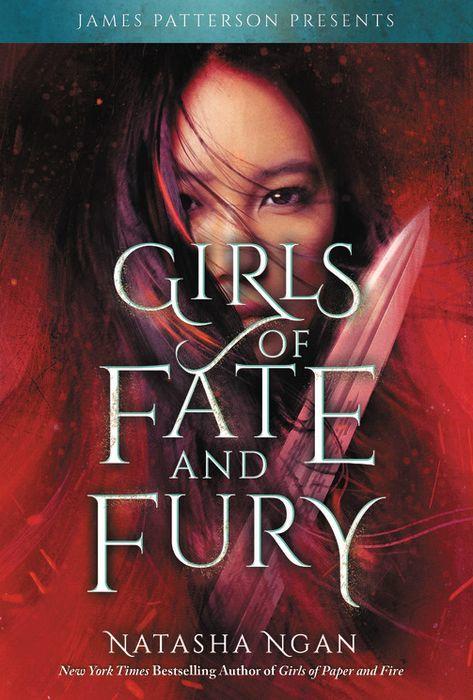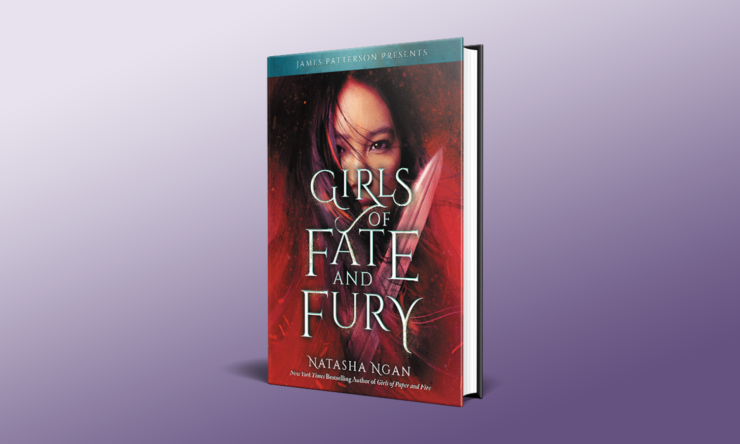When I first read Girls of Paper and Fire in 2019, I was in awe of the intricately built fantasy world and the compelling narrative of two queer girls falling in love and fighting against patriarchal oppression. The final book in the trilogy, Girls of Fate and Fury, brings these characters’ journeys and the revolutionary conflict to a dramatic and emotional close. Lei discovers the insidious plans the Demon King has for her, while Wren is thrust into sudden leadership positions as part of the rebellion. The book further develops ideas of power and strength, explores the tragic choices which are inherent in war, and demonstrates how love enables resistance, no matter the circumstances.
Told in Lei and Wren’s dual perspectives, the book begins with Wren, alone in the aftermath of the chaos which separated the two of them at the end of Girls of Storm and Shadow. Previously, Lei had been captured by the demon Naja and was on her way back to the Demon King’s palace; Wren was fighting the Demon King’s army after the Hannos were betrayed. It’s a timely moment to provide us with greater insight into Wren’s thoughts and motivations—grappling with her duties as a Xia warrior and to her clan, as well as her fears for Lei. In the first book, she was shrouded in intrigue and Lei idealised her; in the second, the darker revelations about her were clouded by Lei’s sense of betrayal. Here, it’s touching to see the extent of Wren’s longing for Lei, although the tension which exploded between the couple prior to their forced separation echoes in both their minds.
As the story progresses, Wren also encounters opportunities for personal growth, as distinct from her archetypal roles as the love interest and warrior: She discovers more about her birth family, the Xia. Wren’s magic and heritage have been so crucial to the series that I found it satisfying to delve into this more deeply as she meets the clan, grapples with her own self-doubt, and considers the morality of using her powers.
Buy the Book


Girls of Fate and Fury
And this is only the beginning of the difficult choices which the characters confront amidst the turmoil of war, with no-one coming out unscathed. Lei is trapped in the Hidden Palace as she was during the first book, but as a changed person: “I learned long ago that Paper has its own power—the ability to ignite, re-form, evolve.” She’s reunited with the remaining Paper Girls, but any comfort is overshadowed by uneasiness—how will the Demon King use them against her? It raises the stakes through Lei’s loyalty to the other girls, and also forces her to reckon with the fallout that occurred in her friendship with Aoki. Yet another change is in the broader allies Lei now has—the people who value her and are willing to make sacrifices for her. Lei learns to empathise more with Wren, who she’d regarded as cold-hearted and cruel at times, as she faces personal guilt over the suffering she is indirectly responsible for:
Wren told me once how no one prepares you for what taking a life costs. She was talking about murder, but there are more ways to be responsible for someone’s death than plunging the blade with your own hand. I wonder if there’s a way to ever get those pieces back, or if you keep existing without them […] your heart never quite as warm as it once was.
As for Wren, there is more to her than simply the perfect warrior that her father expects her to be, even with all her duties. Lei has likewise left an impact on her, and Wren opens up to her emotions and relies on her allies in unguarded moments, in contrast to how isolated she once was.
Echoing the first book, Girls of Fate and Fury explores hierarchies of power and differing ideas of what constitutes strength. On the one hand, there are external structures which exert physical power as a force for destruction: the Demon King’s dominance over Paper women; Ketai Hanno’s insistence on Wren exploiting her magical powers, no matter the cost. Subverting these ideas is the intrinsic power that is found within each of the characters. Lei recalls Zelle’s words from her first time in the palace:
“They can take and steal and break all they want, but there is one thing they have no control over. […] Our minds and hearts are our own.”
This individual power is amplified through the bonds between those who resist the Demon King, and the support Lei receives in what would have otherwise been a hopeless situation. When people work together and care about each other, it can take them far—and when loss and separation occur, this is keenly felt even as the characters must move forward in their fight.
Such power is especially true of the bond between Lei and Wren. I love how their romantic relationship always remains the focal point throughout the series and finale. It’s part of a bigger picture of war and revolution, yet in the eye of the storm are two women who love each other and face the heartaches associated with that love. Even while they are separated, the two constantly think of each other, and it’s emphasised how much the lighter romantic moments between them mean to both girls.
The word ‘fate’ in the book’s title alludes to the birth-blessing ritual which was introduced in the prologue of Girls of Paper and Fire: the character associated with each of them that represents their destinies. Yet the two girls are so entwined by their intimacy and shared experiences that their fates are not distinct—they are linked. Twists are introduced on the meanings of their birth-blessing pendants, and both are forced to grapple with the uncertainties of the other’s futures. It’s this deep connection which makes the climax so exhilarating.
Finally, this book was a reminder of everything I’ve loved about the series’ worldbuilding from the very start, with the author predominantly drawing upon her Malaysian-Chinese background in constructing the setting, while imbuing it with imagination. From the martial arts, qi magic and shamans, to the language, food and architectural aspects of Ikhara, it was so refreshing to be immersed in a thoughtfully developed world in which aspects of my own Chinese culture were included, and where there were wider Asian influences I often recognised. Saying goodbye to the trilogy is bittersweet, but it’s been a thrilling ride, and I’m so excited to see what Natasha Ngan will write next.
Girls of Fate and Fury is available from Jimmy Patterson Books.
Wendy Chen is a writer and reviewer based in Sydney, Australia. Her short fiction has appeared in the anthology Meet Me at the Intersection (Fremantle Press, 2018). You can find more of her book recommendations on her blog, and on Instagram @writteninwonder_










